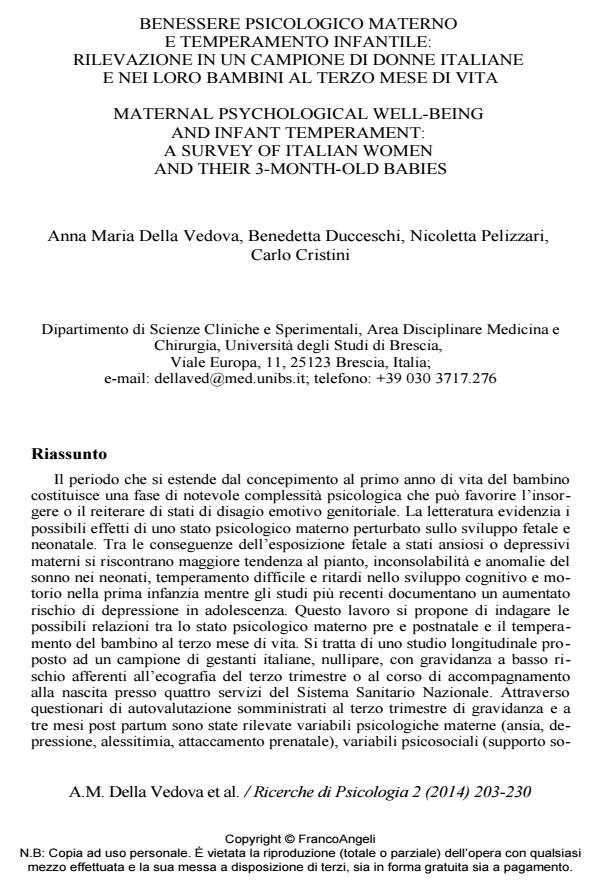Maternal psychological well-being and infant temperament: a survey of italian women and their 3-month-old babies
Journal title RICERCHE DI PSICOLOGIA
Author/s Anna Maria Della Vedova, Benedetta Ducceschi, Nicoletta Pelizzari, Carlo Cristini
Publishing Year 2015 Issue 2014/2
Language Italian Pages 28 P. 203-230 File size 322 KB
DOI 10.3280/RIP2014-002001
DOI is like a bar code for intellectual property: to have more infomation
click here
Below, you can see the article first page
If you want to buy this article in PDF format, you can do it, following the instructions to buy download credits

FrancoAngeli is member of Publishers International Linking Association, Inc (PILA), a not-for-profit association which run the CrossRef service enabling links to and from online scholarly content.
The perinatal period is a phase of relevant psychological complexity which may increase the risk of a development or a recurrence of psychological disturbances in parents. Literature highlights the potential effects of a perturbed maternal psychological state on foetal and newborn development. Among the consequences of foetal exposure to maternal states of depression or anxiety are increased inconsolable crying and sleep disturbances in the newborn, difficult temperament and motor and cognitive development delays in children while recent research points out a higher risk of depression in adolescence. The aim of the study is to investigate the possible relationship between maternal psychological state in the perinatal period and child temperament at three months post partum. It is a longitudinal observational survey in a sample of Italian, low risk nulliparous women, attending prenatal classes or ultrasound examination in the third trimester of pregnancy. Self-assessment questionnaires were administered in the third trimester of pregnancy and at three months postpartum in order to evaluate maternal psychological variables (depression, anxiety, prenatal attachment, alexithymia), psychosocial variables (social support, parental bonding, stressful events), and the temperament of the baby. The study results support the hypothesis that maternal perinatal states of depression or anxiety are associated with difficult temperament of the baby. In particular, higher scores of antenatal depression and postnatal state anxiety were independent predictors of increased temperamental difficulties of the baby. The results emphasize the relevance of maternal perinatal psychological wellbeing and the role of prevention and treatment programs from the early stages of pregnancy.
Keywords: Perinatal depression, anxiety, prenatal attachment, social support, temperament.
- Carlo Cristini: un ricordo a pi&ugrav Alessandro Antonietti, Carlo Cipolli, Rossana De Beni, Anna Maria Della Vedova, Santo Di Nuovo, Mario Fulcheri, Gianbattista Guerrini, Luciano Peirone, Alessandro Porro, Pietro Vigorelli, in RICERCHE DI PSICOLOGIA 4/2022 pp.1
DOI: 10.3280/rip2021oa13098
Anna Maria Della Vedova, Benedetta Ducceschi, Nicoletta Pelizzari, Carlo Cristini, Benessere psicologico materno e temperamento infantile: rilevazione in un campione di donne italiane e nei loro bambini al terzo mese di vita in "RICERCHE DI PSICOLOGIA " 2/2014, pp 203-230, DOI: 10.3280/RIP2014-002001